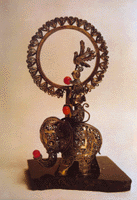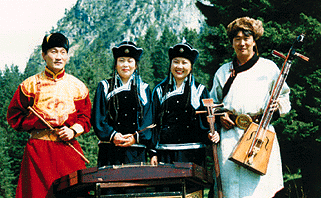|
- Catalog (in stock)
- Back-Catalog
- Mail Order
- Online Order
- Sounds
- Instruments
- Projects
- History Face
- ten years 87-97
- Review Face
- our friends
- Albis Face
- Albis - Photos
- Albis Work
- Links
- Home
- Contact
- Profil YouTube
- Overton Network
P & C December 1998
- Face Music / Albi
- last update 03-2016
|
1. Khan khökhiin uyanga - 10:39
2. Manduul - 6:18
3. Manarch baigaa shil - 4:50
4. Baavai Chinghis - 2:49
5. Dörvön oirdyin uria - 6:57
6. Zuun langiin joroo luus - 2:03
7. Dörvön tsagiin tal - Siilen böör - 3:33
8. Shargyin shargyin joroo - 3:37
9. Dörvön nast khölög baatar - Tuuli - (heroic-epic-myths) - 27:55
10. Höömijn törluud - 5:17
 |
Tumbash is a symbol for four animals, which live peacefully and happily together. According to an Indian fairy-tale, a pigeon, a hare, a monkey and an elephant lived peacefully and happily together and respect the older. Thanks to their friendship and peaceful togetherness, they had been able to achieve a lot. These animals helped an oppressed people to free themselves from the authorities. By holding together with this people, they could overcome the evil prince and chase away.
The word "tumbash" is also mentioned in the ancient Sutra "Subashid", the Treasure of Wisdom.
|

Enkhjargal, Selenge, Sarangerel, Batgerel
Songs
1. Khan khökhiin uyanga
- Enkhjargal: voc (höömij), limbe - Batgerel: voc (höömij), morin khuur - Selenge: yoochin
|
This melody is dedicated to the legend of the Khan Khökhii mountains. When a stag had lost his hind and grieved for her the whole region of the Khan Khökhii mountains, the land, the mountain peaks and even the river mourned with him.
|
2. Manduul
- Enkhjargal: voc (höömij), limbe, tovshuur - Batgerel: morin khuur - Sarangerel: shudraga / shanz - Selenge: yoochin
|
This melody is devoted to the queen Mandukhai, the young wife of king Manduul, who reigned Mongolia from 1463 until 1467. After the king's death, she nominated a wise boy of the royal family as successor to the throne. She became his queen and ruled the kingdom in his name.
|
3. Manarch baigaa shil
- Enkhjargal: voc (höömij), limbe - Batgerel: morin khuur - Sarangerel: shudraga / shanz - Selenge: yoochin
|
This is the melody of a folk song from Southern Mongolia that tells a love story
|
4. Baavai Chinghis
- Enkhjargal: voc (höömij), limbe - Batgerel: morin khuur - Sarangerel: shudraga / shanz - Selenge: yoochin
|
This is a melody from the Buriat Mongoles, dedicated to Genghis Khan.
|
5. Dörvön oirdyin uria
- Enkhjargal: voc (höömij) - Batgerel: voc (höömij), morin khuur
|
This is a melody from Western Mongolia. In past times, the four Oirad tribes united and so this melody became the symbol of their union.
|
6. Zuun langhiin joroo luus
- Enkhjargal: voc (höömij), limbe - Batgerel: voc (höömij), morin khuur - Sarangerel: shudraga / shanz - Selenge: yoochin
|
This was the national anthem of the Bogd empire, the autonomous Mongolia before the people's revolution. The eighth Bogd Javzandambu (Agvaanluvsan) khutagt was the secular and religious ruler of Mongolia from the 29th of December 1911 until the people's revolution in 1921. He became famous as Mongolian emperor (Bogd khan).
|
7. Dörvön tsaghiin tal - Siilen böör
- Enkhjargal: voc (höömij), limbe - Batgerel: morin khuur - Sarangerel: shudraga / shanz - Selenge: yoochin
|
The first part is the melody of the "Song of the four seasons" that formulates the love for a girl.
- Siilen böör is the story of a Mongol, who had shot his fiancée's father by mistake. He had only intended to frighten him with a gunshot.
|
| 8. Sharghyin sharghyin joroo |
Enkhjargal: voc (höömij), limbe - Batgerel: morin khuur - Sarangerel: shudraga / shanz - Selenge: yoochin
This melody is dedicated to horse and love.
|
9. Dörvön nast khölög baatar - tuuli - (heroic-epic-myth)
- Enkhjargal: voc (höömij), tovshuur, hel khuur - Batgerel: morin khuur
|
This is a Mongolian heroic myth of ancient times. The epic describes how the hero overcomes his enemy.
|
10. Höömijn törluud
- Enkhjargal: voc (höömij) - Batgerel: voc (höömji), morin khuur
|
This piece consists of several höömij variations in the kharkhiraa technique (grumbling, croaking höömij used especially for epic songs because of the magnificent and pathetic melody) and the isgaree technique (a kind of whistling höömij) with the khamryn (= nose; the sound passes only through the nose) höömij.
|
|
- Khöömij - (overtone singing, throat singing)
|
|
The performance of overtone singing takes usually place during social events such as eating or drinking parties. |
|
The Mongols call their overtone singing höömij (= throat, pharynx). The singer creates a constant pitched fundamental considered as a drone, and at the same time modulates the selected overtones to create a formantic melody from harmonics. |
|
Several techniques are known, depending on the vocal source and the place of resonance: kharkhiraa = lung, khamryn = nose, tövönkhiin = throat and bagalzuuryn = pharynx. Overtone singers form and vary sound and timbre with their mouth, teeth, tongue, throat, nose and lips. They always form two distinct tones simultaneously sustaining the fundamental pitch. |
|
Overtone singing can also be heard from Turkic-speaking tribes in disparate parts of central Asia. The Bashkir musicians from the Ural Mountains call their style of overtone singing uzlyau; the Khakass call it khai, the Altai call it koomoi and the Tuvinians khoomei. |
|
Up to date, overtone singing is a common feature of Siberian peoples as well as the Kazakhs and Mongolian tribes. Overtone or throat singing is a special technique in which a single vocalist produces two distinct tones simultaneously. One tone is a low, sustained fundamental pitch (a kind of drone) and the second is a series of flutelike harmonics, which resonate high above this drone. Who masters this singing technique may even make the overtone sound louder then the fundamental pitch, so the drone is not audible anymore. A different technique often used by overtone singers combines a normal glottal pitch with the low frequency, pulse-like vibration known as vocal fry. The Turkic tribes in the Altai use to sing their texts in such a low vocal fry register of about 25-20 Hz. |
|
- Tuuli - (heroic-epic myths)
|
Mongolian epics report about fierce fights between good and evil powers in a highly qualified literary poetry.
The recital of epics was always bound to rituals and it was believed to have magical power. The recitation should have a favourable influence on natural spirits as well as the power to expulse evil spirits. Generally, the epics were sung inside the round felt tents of the shepherds, during the period of their search for the winter quarters, before the hunt or a battle, and against infertility or disease.
|
Instruments:
|
- Morin khuur (string instrument - horse-head-violin)
|
|
The morin khuur is a typical Mongolian two-stringed instrument. The body and the neck are carved from wood. The end of the neck has the form of a horse-head and the sound is similar to that of a violin or a cello. The strings are made of dried deer or mountain sheep sinews. It is played with a bow made of willow, stringed with horsetail hair and coated with larch or cedar wood resin.
|
|
This instrument is used to play polyphonic melodies, as with one stroke of the bow the melody and drone-strings can be played at the same time. The morin khuur is the most widespread instrument in Mongolia, and is played during celebrations, rituals and many other occasions, as well as an accompaniment for dances or songs. Even the sound and noises of a horse herd are imitated on the morin khuur.
|
|
People say that it is connected with a handsome man. It is also played when a ewe doesn't want to suckle her lamb.
There is a legend about the origin of this instrument. A Mongol missed his dead horse so much that he used its head, its bones and its hair to build an instrument on which he started to play the familiar noises of his beloved horse.
|
|
- Khun tovshuur - Tovshuur (string instrument)
|
|
The khun tovshuur is a two-stringed instrument similar to the lutes of Tuva, Altai or Kazakhstan. The body and the neck are carved from cedar wood and the body is often coated with the leather of wild animals, camels or goats. The strings are plaited with the horsetail hair and tuned in the interval of a fourth.
|
|
The West Mongols use this lute to accompany the "tuuli" (heroic-epic myths) and the "magtaal" (praise songs).
|
|
- Shudraga / Shanz (string instrument)
|
|
The shudraga or shanz is a long-necked spiked lute with an oval wooden frame with snakeskin covering stretched over both faces. The three strings are fixed to a bar, which is inserted in the body. The instrument is struck or plucked with a plectrum made of horn or with the fingers. As the tones do not echo, every note is struck several times.
|
|
- Yoochin (string instrument)
|
|
The yoochin is a box zither, a dulcimer with 13 double-wire strings. The strings are struck with two wooden sticks, so-called little wooden hammers (it is comparable with the santur of the Persians). It has a black wooden soundboard richly decorated with ornaments.
|
|
The instrument was only familiar to townspeople and in the beginning of all only they played it.
|
|
- Limbe (wind instrument - transverse flute)
|
|
The instrument is frequently used in accompaniment, occasionally also as a solo instrument. In former times, these flutes were made of bamboo or wood, nowadays mostly of plastic, particularly the instruments that are imported from China. These flutes are closely bound up with the nomads of Central Asia.
|
|
The length of the instrument is approx. 64 cm, with nine holes, whereof one is the blowhole and two others are reserved for the tuning. It is often played with circular breathing*. The sound reflects what is heard in the nature or the sounds of the natural and social environment.
|
|
- *Circular breathing: one note is blown, while the musician inhales through his nose. The air is collected inside the cheeks and exhaled by the pressure of the cheeks' muscles (same principle as for the bagpipe). The base of the tongue is used as a valve.
|
|
- Hel khuur (Jew's harp)
|
|
Nowadays, a Jew's harp is usually made of brass or steel, but in earlier days it was made of wood or bamboo. A spring, acting as a vibrator, is fitted into a horseshoe-shaped metal holder and is called 'tongue'. The player places the long part of the instrument close to his mouth, touching it with his front teeth and manipulating the tongue with his right hand. The pitch can be varied by changing the shape of the mouth cavity, which at the same time acts as a resonance chamber.
|
More information on the history of the Mongols and traditional songs from Mongolia see:
- Duo Temuzhin, "Altai-Khangain-Ayalguu", FM 50023
- Ensemble Temuzhin, "Altai-Khangain-Ayalguu 2", FM 50026
- Ensemble Ardiin Ayalguu, Solongo, FM 50024.
Many thanks to Enkhjargal Chuluunbaatar, Selenge Zangad, Batgerel Tsegmed , Sarangerel Shagdarsuren,
Oyuntuya Saldan and Silvia Delorenzi-Schenkel for helping with the translation
|
